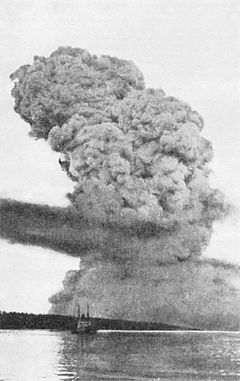 The pyrocumulus cloud produced by the explosion | |
 | |
| Date | 6 December 1917 |
|---|---|
| Time | 9:04:35 am (AST) |
| Location | Halifax, Nova Scotia, Canada |
| Deaths | 1,782 (confirmed) |
| Non-fatal injuries | 9,000 (approximate) |
On the morning of 6 December 1917, the French cargo ship SS Mont-Blanc collided with the Norwegian vessel SS Imo in the harbour of Halifax, Nova Scotia, Canada. Mont-Blanc, laden with high explosives, caught fire and exploded, devastating the Richmond district of Halifax. At least 1,782 people were killed, largely in Halifax and Dartmouth, by the blast, debris, fires, or collapsed buildings, and an estimated 9,000 others were injured. The blast was the largest human-made explosion at the time.[1] It released the equivalent energy of roughly 2.9 kilotons of TNT (12 TJ).[2]
Mont-Blanc was under orders from the French government to carry her cargo from New York City via Halifax to Bordeaux, France. At roughly 8:45 am, she collided at low speed, approximately one knot (1.2 mph or 1.9 km/h), with the unladen Imo, chartered by the Commission for Relief in Belgium to pick up a cargo of relief supplies in New York. On Mont-Blanc, the impact damaged benzol barrels stored on deck, leaking vapours which were ignited by sparks from the collision, setting off a fire on board that quickly grew out of control. Approximately 20 minutes later at 9:04:35 am, Mont-Blanc exploded.
Nearly all structures within an 800-metre (half-mile) radius, including the community of Richmond, were obliterated.[3] A pressure wave snapped trees, bent iron rails, demolished buildings, grounded vessels (including Imo, which was washed ashore by the ensuing tsunami), and scattered fragments of Mont-Blanc for kilometres. Across the harbour, in Dartmouth, there was also widespread damage.[4] A tsunami created by the blast wiped out a community of Mi'kmaq who had lived in the Tufts Cove area for generations.
Relief efforts began almost immediately, and hospitals quickly became full. Rescue trains began arriving the day of the explosion from across Nova Scotia and New Brunswick while other trains from central Canada and the Northeastern United States were impeded by blizzards. Construction of temporary shelters to house the many people left homeless began soon after the disaster. The initial judicial inquiry found Mont-Blanc to have been responsible for the disaster, but a later appeal determined that both vessels were to blame. The North End of Halifax has several memorials to the victims of the explosion.
- ^ Knauer 2012, p. 56.
- ^ Ruffman & Howell 1994, p. 276.
- ^ Armstrong 2002, p. 42.
- ^ "Halifax Explosion 1917". CBC. 19 September 2003. Archived from the original on 14 May 2011. Retrieved 25 February 2011.